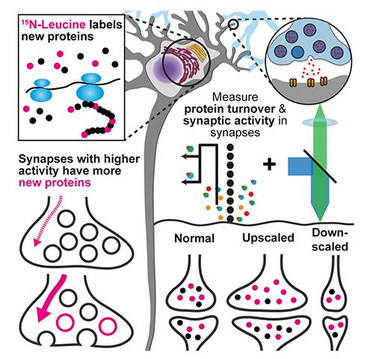How synapses maintain their activity despite ageing

Synapses, the communication sites between nerve cells, are key to the function of the neural system and have been extensively studied over the last decades. Especially synaptic vesicles, which store, transport and release messenger substances (neurotransmitters) and are thus crucial to synaptic transmission, have been described in great detail. During information transmission between nerve cells, synaptic vesicles release neurotransmitter by fusing to the membrane (exocytosis), synaptic vesicles are reformed (endocytosis) and eventually recycled for another round of neurotransmitter release. This process is known as the synaptic vesicle cycle. Most of the components involved in this cycle have been elucidated. To date, it is thus known, that these components age and once aged have to be removed in order to prevent damage to the nerve cells. Consequently, synaptic vesicles can undergo the vesicle cycle only a limited amount of times and ageing is happening in an activity dependent way. This means the more active a synapse is, the faster its vesicles age. While the fundamentals of synaptic vesicle and protein ageing have been largely elucidated, very little is known so far about the supply of new vesicles to the synapses, and how this process is regulated. Learning more about this process and the involved synaptic components will help us to further enhance our understanding of synaptic maintenance and function.
To understand how synaptic activity can be maintained despite ageing, Göttingen scientists established a mathematical model of the synaptic vesicle-cycle, and verified their theoretical findings with a combination of fluorescence imaging and secondary ion mass spectrometry. The collaborative effort was led by Prof. Dr. Silvio O. Rizzoli, Director of the Institute of Neuro- and Sensory Physiology of the University Medical Center Göttingen (UMG), and speaker of the Board of the Center for Biostructural Imaging of Neurodegeneration (BIN), and Dr. Viola Priesemann, group leader at the Max Planck Institute for Dynamics and Self-Organization and associated with the Faculty of Physics of the Georg-August-University Göttingen as well as the Bernstein-Center for Computational Neuroscience. Using mathematical modeling of the synaptic vesicle cycle they could show that synapses theoretically require a demand-dependent supply of newly made synaptic vesicles. This compensates for the ageing of synaptic proteins and ensures a robust synaptic transmission. The study reveals that the theoretical requirement is reflected in living nerve cells by a positive correlation between presynaptic protein turnover and synaptic activity on the single synapse level. Disrupting transport to synapses abolishes this relation, suggesting that synaptic protein transport plays a role in demand-dependent vesicle supply. The results of the scientists engaged in the Cluster of Excellence Multiscale Bioimaging (MBExC) and the Göttingen Collaborative Research Centers 1286 (SFB1286) were published in the renowned scientific journal “Cell Reports” on March 16, 2021.